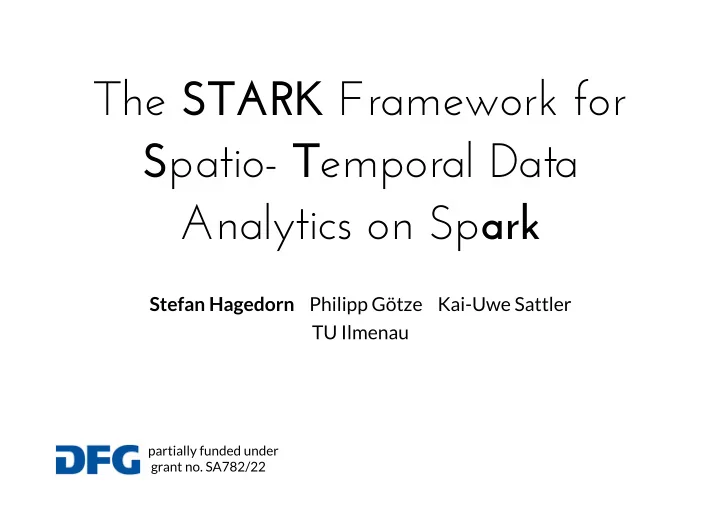

The STARK Framework for S patio- T emporal Data Analytics on Sp ark Stefan Hagedorn Philipp Götze Kai-Uwe Sattler TU Ilmenau partially funded under grant no. SA782/22
Motivation data analytics for decision support include spatial and/or temporal information sensor readings from environmental monitoring satellite image data event data data sets may be large or may be joined with other large data sets Big Data platforms like Hadoop or Spark don't have native support for spatial (spatio-temporal) data
What do we want? event information (extracted from text) find correlations easy API/DSL fast Big Data platform (Spark/Flink) spatial & temporal flexible operators aspects & predicates
Outline 1. Existing Solutions 2. STARK DSL Data representation Integration Operators 3. Make it fast Partitioning Indexing 4. Performance evaluation
Existing Solutions ... and why we didn't choose them Hadoop-based slow long Java programs HadoopGIS, SpatialHadoop, GeoMesa, GeoWave for Spark GeoSpark special RDDs per geometry type (PointRDD, PolygonRDD) - no mix! unflexible API crashes & wrong results! SpatialSpark CLI programs no (documented) API
STARK DSL Spark Scala API example case class Event(id: String, lat: Double, lng: Double, time: Long) val rdd: RDD[Event] = sc.textFile( "/events.csv" ) .map(_.split( ",")) .map(arr => Event(arr(0), arr(1).toDouble, arr( 2).toDouble, arr( 3).toLong) .filter(e => e.lat > 10 && e.lat < 50 && e.lng > 10 && e.lng < 50) .groupBy(_.time) Problem: Spark does not know about spatial relations: no spatial join! Goal: exploit spatial/temporal characteristics for speedup useful and flexible operators predicates distance functions integrate analysis operators as operations on RDDs seamless integration so that users don't see extra framework
STARK DSL Data Representation case class STObject(g: GeoType, t: Option[TemporalExpression ]) extra class to represent spatial and temporal component time is optional defines relation-operators to other instances def intersectsSptl (o: STObject) = g.intersects(o.g) def intersectsTmprl (o: STObject) = (t.isEmpty && o.t.isEmpty || (t.isDefined && o.t.isDefined && t.get.intersects(o.t.get))) def intersects (t: STObject) = intersectsSpatial(t) && intersectsTemporal(t) Φ( o , p ) ⇔ Φ ( s ( o ), s ( p )) ∧ ( s ( t ( o ) = ⊥ ∧ t ( p ) = ⊥) ∨ ( t ( o ) ≠ ⊥ ∧ t ( p ) ≠ ⊥ ∧ Φ ( t ( o ), t ( p ))) t
STARK DSL Integration User program val qry = STObject("POLYGON(...)" , Interval(10,20)) val rdd: RDD[(STObject, (Int, String))] = ... val filtered = rdd.containedBy(qry) val selfjoin = filtered.join(filtered, Preds.INTERSECTS ) STARK class STRDDFunctions [T](rdd: RDD[(STObject, T)]) { def containedBy (qry: STObject) = new SpatialRDD (rdd, qry, Preds.CONTAINEDBY ) } implicit def toSTRDD[T](rdd: RDD[(STObject, T)]) = new STRDDFunctions (rdd) we do not modify the original Spark framework Pimp-My-Library pattern: use implicit conversions
STARK DSL Operations Predicates contains containedBy intersects withinDistance can be used for filters and joins with and without indexing clustering: DBSCAN k-Nearest-Neighbor search Skyline supported by spatial partitioning
Make it fast Flow
Make it fast Partitioning Spark uses Hash parititioner by default does not respect spatial neighborhood Fixed Grid Parititoning divide space into n partitions per dimension may result in skewed work balance
Make it fast Partitioning Cost-based Binary Split divide space into cells of equal size partition space along cells create partitions with (almost) equal number of elements repeat recursively if maximum cost is exceeded
Make it fast Partition Pruning - Filter SpatialFilterRDD(parent: RDD, qry: STObject, pred: Predicate) extends RDD { def getPartitions = { def compute(p: ________) = { for elem in p: _ if (pred(qry,elem)) __ yield elem } } }
Make it fast Partition Pruning - Join SpatialJoinRDD(left: RDD, right: RDD, pred: Predicate) extends RDD { l, r def getPartitions = { def compute(p: ________) = { for l in left.partitions: for i in l: for r in right.partitions: for j in r: if l intersects r: if pred(i,j): yield SptlPart(l,r) yield (i,j) } } }
Make it fast Indexing Live Indexing index is built on-the-fly query index & evaluate candidates index discarded after partition is complety processed def compute(p: Partition ) { tree = new RTree() for elem in p: tree.insert(elem) candidates = tree.query() result = candidates.filter(predicate) return result }
Make it fast Indexing Persistent Indexing transform to RDD containing trees can be materialized to disk no repartitioning / indexing needed when loaded again RDD[RTree[...]] Partition
Evaluation Filter 10.000.000 polygons 16 Nodes, 16 GB RAM each, Spark 2.1.0
Evaluation Filter - Varying range size 50.000.000 points
Evaluation Join
Evaluation Join GeoSpark produced wrong results! 110.000 - 120.000 result elements missing
Conclusion framework for spatio-temporal data processing on Spark easy integration into any Spark program (Scala) filter, Join, clustering, kNN, Skyline spatial partitioning indexing partitioning / indexing not always useful / necessary performance improvement when data is frequently queried https://github.com/dbis-ilm/stark
Partitioning & Indexing val rddRaw = ... val partitioned = rddRaw.partitionBy( new SpatialGridPartitioner (rddRaw, ppD= 5)) val rdd = partitioned.liveIndex(order= 10).intersects( STObject(...)) val rddRaw = ... val partitioned = rddRaw.partitionBy( new BSPartitioner (rddRaw, cellSize= 0.5, cost = 1000*1000)) val rdd = partitioned.index(order= 10) rdd.saveAsObjectFile( "path") val rdd1:RDD[RTree[STObject,(...)]] = sc.objectFile( "path")
Partition Extent partition 1 partition 2 q
Clustering val rdd: RDD[(STObject, (Int, String))] = ... val clusters = rdd.cluster(minPts = 10, epsilon = 2, keyExtractor = { case (_,(id,_)) => id } ) relies on a spatial partitioning extend each partition by epsilon in each direction to overlap with neighboring partitions local DBSCAN in each partition merge clusters if objects in overlap region belong to multiple clusters => merge clusters
Recommend
More recommend